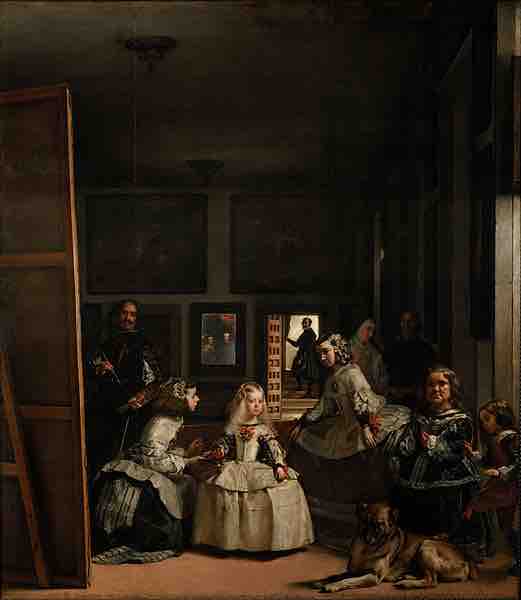Overview: The Spanish Golden Age
The Spanish Golden Age is a period of flourishing in arts and literature in Spain, coinciding with the Baroque era and the political rise and decline of the Spanish Habsburg dynasty. It began no earlier than 1492 with the end of the Reconquista (Reconquest), the sea voyages of Christopher Columbus to the New World, and the publication of Antonio de Nebrija's Gramática de la lengua castellana (Grammar of the Castilian Language). Politically, it ended no later than 1659 with the Treaty of the Pyrenees, ratified between France and Habsburg, Spain.
Spain, in the time of the Italian Renaissance, had seen few great artists come to its shores. The Italian holdings and relationships made by Ferdinand of Aragon, Queen Isabella's husband and later Spain's sole monarch, launched a steady traffic of intellectuals across the Mediterranean between Valencia, Seville, and Florence. Luis de Morales, one of the leading exponents of Spanish Mannerist painting, retained a distinctly Spanish style in his work reminiscent of medieval art. Spanish art, particularly that of Morales, contained a strong mark of mysticism and religion that was encouraged by the Counter-Reformation and the patronage of Spain's strongly Catholic monarchs and aristocracy.
Artists of the Golden Age of Spain
The Habsburgs, both in Spain and Austria, were great patrons of art in their countries. Diego Velázquez and Francisco de Zurbarán are often considered by scholars as the influential founders of a uniquely Spanish style of painting during the Baroque era.
Diego Velázquez
Diego Velázquez is widely regarded as one of Spain's most important and influential artists. He was an individualistic artist of the contemporary Baroque period and most well-known as a portrait artist. In addition to numerous renditions of scenes of historical and cultural significance, he painted scores of portraits of the Spanish royal family, other notable European figures, and commoners, culminating in the production of his masterpiece Las Meninas (1656). Velázquez was a court painter for King Philip IV and found increasingly high demand for his portraits from statesmen, aristocrats, and clergymen across Europe. His portraits of the King, his chief minister, the Count-duke of Olivares, and the Pope himself demonstrated a belief in artistic realism and a style comparable to many of the Dutch masters.
Philip IV in Brown and Silver, 1632
Velázquez is perhaps most well-known for his many famous portraits, including this one of King Philip IV.
Velazquez's most famous painting, however, is the celebrated Las Meninas (1656), in which the artist includes himself as one of the subjects. Las Meninas (Spanish for "The Ladies in Waiting") is a painting with complex and enigmatic composition that raises questions about reality and illusion, creating an uncertain relationship between the viewer and the figures depicted. Because of these complexities, Las Meninas has been one of the most widely analyzed works in Western painting.
The painting shows a large room in the Royal Alcazar of Madrid during the reign of King Philip IV and presents several figures, most identifiable from the Spanish court, captured in a particular moment as if in a snapshot. Some look out of the canvas towards the viewer, while others interact among themselves. The young Infanta Margaret Theresa is surrounded by her entourage of maids of honor, chaperone, bodyguard, two other figures, and a dog. Just behind them, Velázquez portrays himself working at a large canvas. Velázquez looks outwards, beyond the pictorial space to where a viewer of the painting would stand. In the background there is a mirror that reflects the upper bodies of the king and queen. They appear to be placed outside the picture space in a position similar to that of the viewer, although some scholars have speculated that their image is a reflection from the painting Velázquez is shown working on.

Las Meninas, 1656 (English: The Ladies in Waiting)
In his most celebrated painting, Valzquez's self-portrait is included on the left.
Religion in the Art of the Spanish Golden Age: Francisco de Zurbarán
The religious element in Spanish art, in many circles, grew in importance with the Counter-Reformation. The austere, ascetic, and severe work of Francisco de Zurbarán exemplified this thread in Spanish art, along with the work of composer Tomás Luis de Victoria. Philip IV actively patronized artists who agreed with his views on the Counter-Reformation and religion. The mysticism of Zurbarán's work—influenced by Saint Theresa of Avila—became a hallmark of Spanish art in later generations.

The Birth of the Virgin
The Birth of the Virgin, by Francisco de Zurbarán, demonstrates the religious themes, particular the devotion to the Virgin Mary, that pervaded Counter-Reformation Spanish artwork.
Influenced by Caravaggio and the Italian masters, Zurbarán devoted himself to an artistic expression of religion and faith. He is known primarily for his religious paintings depicting monks, nuns, and martyrs, as well as for his still-lifes. Zurbarán gained the nickname Spanish Caravaggio, owing to the forceful, realistic use of chiaroscuro in which he excelled.
Saint Francis in Meditation, c. 1631–1640, National Gallery
Zurbarán's painting of Saint Francis of Assisi is notable for its use of chiaroscuro, or high contrast between light and dark.
His paintings of St. Francis of Assisi, the immaculate conception, and the crucifixion of Christ reflected a third facet of Spanish culture in the 17th century, against the backdrop of religious war across Europe. Zurbarán broke from Velázquez's sharp realist interpretation of art and looked, to some extent, to the emotive content of the painter El Greco and the earlier Mannerist painters for inspiration and technique, though Zurbarán respected and maintained the lighting and physical nuance of Velázquez.